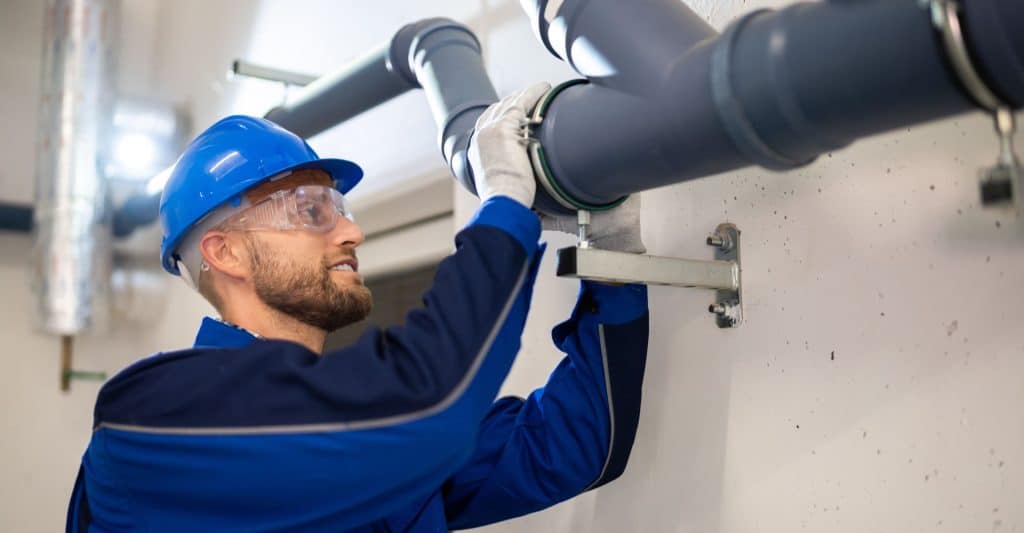
How to Stop Water Leaks from PVC Pipe Joints
Overview
Experiencing a leak from the PVC pipe joint is common in households. Typically identified by their white or cream color, PVC pipes are renowned for their extensive durability and lightweight properties. It makes them ideal for sewage, drain pipes, plumbing, and irrigation.
However, at some time, you may detect a leak in your PVC pipe somewhere in your home. When this happens, addressing it as soon as possible is critical. While modest repair is doable with a few easy fixes, leakage beyond repair requires an entire replacement from expert plumbers in San Jose. To help you keep the leaking under control until you find a permanent fix, we’ve enlisted straightforward ways to avoid further damage.
Say No To PVC Leaks — Top Ways to Fix a Leaky PVC Pipe
Every PVC (polyvinyl chloride) leaking pipe requires a different solution depending on the damage extent and the root cause. Consider the following varied fixes to repair it temporarily:
• Fiberglass Resin Tape
It is an ideal and effective solution if you intend to slow down the damage. It shows its magic through a water-activated resin that solidifies after being applied to the pipe and eventually slows the leaking. But before applying, thoroughly clean the afflicted area with a cloth. Wait for 15 minutes to let the resin get hardened.
This fix is perfect for modest repairs that can wait for a prolonged time. But don’t consider it a lasting solution! Get it repaired professionally by the emergency plumbing repair experts.
• Epoxy Putty
Available in putty or liquid form, repair epoxies are designed to repair PVC pipe cracks or leaking fittings. To use this solution, clean the area first with a cloth. Ensure the area is dry before working. Afterward, mix the putty or liquid according to the manufacturer’s guidelines. Remember, you’ve limited time to work with it after you’ve mixed. So, comprehensively apply the epoxy instantly over the damaged areas. Wait for 20-25 minutes to allow the epoxy to solidify. Read the guidelines before using it, as each epoxy works slightly differently.
• Silicon Repair Tape
Count on silicon repair tape to handle the issue when dealing with minor leaks. It utilizes rubber to seal the leak. Like fiberglass resin tape, it’s also available in a roll to wrap directly around the PVC pipe. Similarly performed in every other temporary fix, clean the damaged area before starting the repair. Now, tightly wrap the tape around the pipe. But, be careful while performing this, as it may stick to itself instead of adhering to the pipe. Now, test the pipe, and if the leak persists, it’s best to engage plumbers in Sacramento to repair the leak.
• Rubber and Hose Clamps
It’s another effective method to repair the PVC leak temporarily. Hose clamps fix small leaks in a PVC pipe using compression. Start by wrapping the rubber around the leaky part and installing the hose clamps over the rubber. Appropriately tighten them to stop or slow the leak. The clamps will seal the leak if positioned correctly. Take this repair method as a transient fix since it will become ineffective if the leak grows. So, use the hose clamps until the professionals arrive.
• PVC Pipe Replacement
Should the pipe be beyond repair, replacing the pipe will be the only option. The replacement process usually entails cutting the pipe and installing new couplings and replacement parts. Since PVC is an inexpensive pipe, you can find it at any hardware shop. The steps typically involve the following:
• Cutting the pipe’s damaged section using a hacksaw or ratchet cutter.
• Remove all the leftover water and clean the area with a dry cloth.
• Once the damaged section is cut and the area is dry, fit the replacement in the hole appropriately. Ensure it snugly fits in the existing PVC.
• Now, apply PVC primer solvent to the replacement pipe’s fittings and its exterior side. • Lastly, apply the glue to the PVC pipe and insert it into the replacement fittings.
• Hold the pipe firmly for 10-15 minutes to ensure the replacement party is securely fitted and test the leak.
Remember, it’s a general fixing repair, and avoid using them for long periods, as these aren’t meant to give lasting, permanent results. When you experience PVC pipe leaking, it’s best to call reliable plumbers in Stockton to save your day. Additionally, pay attention to the warning signs of a leaky PVC pipe, like foul stinks in the home, consistent dripping sound, mold development or discoloration, and visible water or moisture. Staying proactive can help prevent pipe leaking and save expensive plumbing repairs.
Prevalent Reasons for PVC Leaks
The following are the top culprits that trigger PVC pipe leaking:
• Age of the Pipe
Frequent temperature fluctuations, like consistent exposure to UV light and thermal cycling, make your pipes prone to wear and tear over time. Consequently, the pipe’s walls become fragile, inflicting potential leaks due to high water pressure.
• Poor Installation
Inappropriately installed pipes are the prime suspect for PVC pipe leaks. During the installation, if adhesive or the activator is lacking on your pipes or a person in charge applies excessive force when joining the pipes, your pipes are more likely to break.
• Errors at the Joints
Failure at the joints is the common reason for PVC leaks. If the PVC surface isn’t prepared well for a secure connection, or the pipe’s angle of insertion into PVC fitting isn’t precise, the odds of PVC join failure may eventually increase.
• Freezing Temperatures
PVC pipes can become brittle and damaged during severe winter weather conditions, irrespective of their resistance to freezing. Hence, if you reside in a region where the temperature drops to low levels, consider insulating your pipes to avoid pipe freezing.
Final Thoughts
Fixing PVC leaking pipes seems straightforward to repair with a few easy-to-use materials. But it’s best to engage a plumber to ensure lasting and permanent repair. Permanent fixes require the necessary tools and equipment to address the issue appropriately. Hire an experienced, licensed, and certified 24-hour plumber to accomplish the task for you. Take quotes from multiple plumbing contractors to ensure you have made an informed decision and entrusted your plumbing task to a reliable person.


 Request a Service
Request a Service